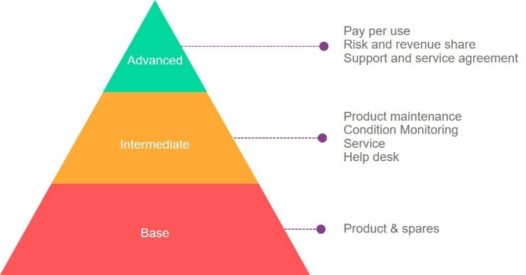Servitization is more commonly associated with discrete manufacturers, but process manufacturers are also embracing this change in business strategy.
Servitization only applies to discrete manufacturing?
Many people think of servitization as only being applicable to discrete manufacturers who have products that they can service and supply spare parts to, or manufacturers who can easily change their business model from selling a product, to selling an outcome; like selling light rather than lightbulbs, or heat rather than heaters.
Servitization is about changing the business model, from selling products, to selling services that support products, and then finally, to selling services to support customers, i.e. selling what the products enable.
Servitization is recognized as having three levels, starting at a base level; selling products and spares, through to an advanced level selling just a service. For process manufacturers the base level is not a suitable place to start, as it is not that easy to sell spare parts for a tin of paint or a packet of aspirin.

The intermediate level of servitization is also not a suitable candidate to achieve servitization in process manufacture, as again, it’s not easy servicing or condition monitoring a pack of salad or a chicken pie! But there is still some opportunity at this intermediate level to sell services in terms of help, consultancy or hospitality – factory tours, restaurants etc.
At the advanced level it is much easier to see how process manufacturers could adopt a servitization model. In fact, many have done so, and the benefits of such an approach are clear to see:
- A sharing of the risk
- A reduction in waste
- Improved quality
- A reduced cost
- Customer ‘lock in’
- Predictable revenues
To get started in servitization in your business you need to think differently, ask yourself this: what do my products do? And then ask yourself, could I supply what they do as a service?
It’s a bit like Edward de Bono’s famous “lateral thinking”, looking at a problem in a different way by looking from a different direction. If your problem is that you need to increase revenue then the obvious solution is to increase sales of your products, but that typically requires investment in plant, marketing and operational staff. Whereas selling a service in addition to your product or just selling the outcome to your customer increases revenue without the capital investment.
Industry Sector Thoughts and Real Examples
Life Sciences
Servitization in process manufacture is often driven from a sharing of risk and cost, which is why many pharmaceutical manufacturers are looking for alternatives to selling pills.
Outcome-based contracts are a good example of this ‘risk sharing’, where the payer pays for an outcome of the drug rather than the drug itself, and the benefits are clear:
- Reducing payers’ risk of buying a product that doesn’t deliver on its promise
- Enabling access to biopharmaceuticals for consumers much earlier
- Offering more effective pricing mechanisms
- Serving as a catalyst for generating global data and evidence of treatment effectiveness.
- Manufacturers can use outcome-based contracts to differentiate the effectiveness of their product versus their competitors’
However, there are difficult barriers that need to be overcome before this type of servitization is commonplace in the life sciences industry.
Agreeing upon outcomes that are measurable within a reasonable timeframe is difficult and manufacturers do not wish to accept financial consequences, especially because they can’t control how a drug is prescribed or used. Probably the biggest issue is capturing the data, because most clinical data is with the manufacturer and until it ends up being captured by the patient then adoption will be slow.
There are, however some examples, one being Novartis, that involved a drug called Entresto, which was introduced in 2015 to treat congestive heart failure. Novartis created agreements, in which it committed to reduce the price of Entresto to payers, if the rate of heart failure hospitalization of patients taking the drug exceeded a specified number. In return, Entresto was given preferred status for this type of treatment.

Chemicals
How to adopt a servitization model in the chemicals industry is clearer because many of the products manufactured in this sector do produce measurable outcomes, heat generated, light reflected, reactive efficiency, etc.
IFS supports many customers in this sector that have already built models around selling a service. One interesting example is Jotun a leading coatings manufacturer, headquartered in Norway. One of Jotun’s largest markets is the coating of ship’s hulls.
Jotun’s analysis service isolates the impact of a ship’s underwater surface on its energy efficiency by tracking relative changes in the relationship between the power delivered to the propeller and speed through water over time.
Jotun has developed a set-up for performance-based contracting where Jotun either documents that high hull performance has been delivered, or returns the additional investment in the hull performance solution. Customers are in effect paying for delivered high performance – not for paint with the promise of high performance.
Food and Beverage
Food and beverage is a difficult industry for the adoption of servitization, because if you grow or manufacture food products then the outcomes are happy, well-fed, healthy customers, which is a difficult outcome to sell as a service.
However, companies like Gousto and Hello Fresh have done just that, they sell you a weekly set of meals, not a product as such, they are selling you the outcome that you will be fed for a full week.
In addition to this type of servitization, restaurants, tours and taprooms are services increasingly being offered by SME food and drink manufacturers, as the shift to servitization in these types of businesses increases.
Servitization has the effect of moving risk from customer to supplier so by definition the supplier has a much higher focus on quality, waste and innovation.
The ultimate servitization for food and beverage is when the retailers no longer buy a product at all, they just sell shelf space which the producers and manufacturers keep stocked. The mechanics and logistics of doing this in food and beverage is obviously huge, but hey isn’t that a bit like the Amazon model?

Summary
So whatever you make or produce there is an opportunity for service revenue as well as product revenue, all you need to do is think differently!
If you would like help or more information on this subject then you may find this Servitization visioning Guide useful.
If you enjoyed this blog please look out for others on IFSBlogs.
I welcome comments on this or any other topic concerning process manufacturing.
Connect, discuss, and explore using any of the following means:
- Twitter: @ElkinsColin
- Email: elkins@ifsworld.com
- Blog: http://blog.ifs.com/author/colin-elkins
- LinkedIn: https://www.linkedin.com/in/colinelkins